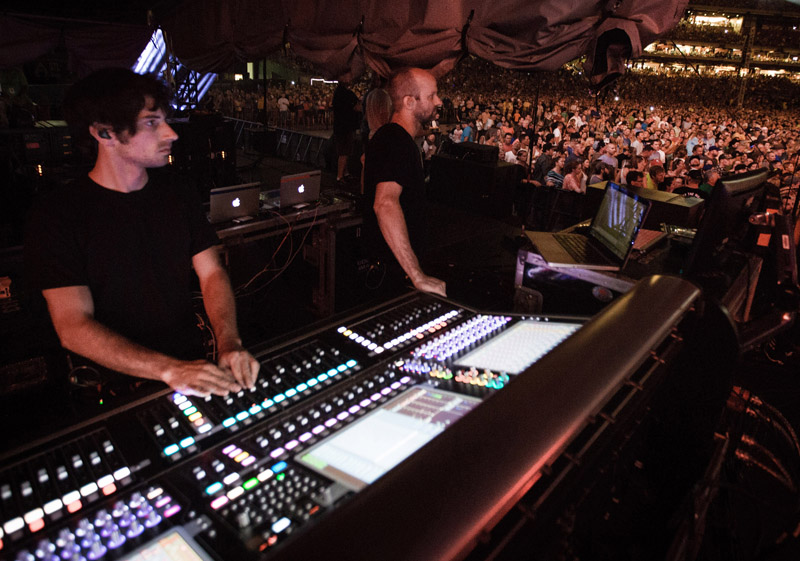
Doing Many Things
Monitor engineer Andy Hill subscribes to the notion that less is more in most situations, even as he stands looking at his SD7 that’s just about maxed-out in terms of processing with the 160 inputs he’s dealing with onstage.
“I couldn’t imagine doing this on another platform,” he says with conviction. “I don’t think I could handle all the ins-and-outs and complexities of what we’re doing. My ability to essentially do anything I want with any channel or any button has been invaluable. We have multi-instrumentalists onstage that require different mixes for the different instruments they play. There are a lot of people, guests included. doing so many different things, and certain songs are more complex than others.
“The actual mixing is the most complicated part,” he continues. “Different people sing lead, play lead, there are a multitude of different fills. Just keeping track of that so everyone hears things at the appropriate level and time keeps me on my toes. I don’t go more than a half second without moving a fader of some kind.”
One way Hill keeps things as simple as possible in his complex world is to set up his required input channels in a separate fashion so that he can simply un-mute them when they’re needed. For example, for the band members who play both guitar and keys on different songs, he sets up separate channels that accommodate both instruments. Then he simply un-mutes them when required and mutes them when they’re not.
“This way, I don’t have to make an actual level change,” he explains. “It’s harder to get a level change exactly right on the fly than it is to just mute and un-mute a channel. I do the latter entirely with the automation on the console, I have a snapshot for each song. When I change a snapshot, I know everything is either correctly muted or un-muted for everyone, and then I just concentrate on balancing the mix.”

Fairly Quiet
When Brown plays electric guitar, it runs through a pair of 4 x 12 cabinets residing directly behind him onstage. This fact notwithstanding, Hill still describes his workspace as a “fairly quiet stage,” with everyone tuned-in to the proceedings courtesy of 20 channels of Sennheiser SR2050 IEM receivers and transmitters working with Jerry Harvey JH16 in-ear monitors. Outfitted with eight drivers per ear, the JH16s give Hill the low-distortion detail and accuracy he’s after with increased headroom.
Brown’s lead vocals are captured via a Sennheiser 5000 Series wireless unit coupled with an MD 5235 capsule, a pattern that repeats itself for the other musicians when they need wireless elsewhere on the elaborate set, and for backing vocals. All instruments, including horns, are spread across 22 channels of instrument wireless. Wired microphones for band members are Sennheiser e 935s.
Drums and percussion utilize an varied collection of mics, with kick sounding forth via a Shure BETA 52, Shure SM57s on snare, Sennheiser e 604s on toms, a Shure SM7 for high-hat, Sennheiser e 604s applied to rack and floor toms, large-diaphragm AT-4050s from Audio-Technica positioned as overheads, and a percussion section served by a phalanx of more SM57s, Sennheiser MK4s for overheads, and other offerings.

Ready For More
To be sure, there are daring moments to be witnessed on the Jekyll + Hyde Tour, both in a technical sense and among the excursions made by the band into uncharted territories, whether they be with guest artists like Kid Rock leading the crowd in a sing-along of Stephen Stills’ “Love the One Your With” or taking on songs like “Beautiful Drug” with its house-resonating bass loops and club-sounding synths.
“Anything can happen out here,” Hill says on a parting note. “You just have to be ready, otherwise you’ll find yourself quickly chasing your own tail. That’s what has always made this one of modern country’s most compelling acts. Whatever happens going forward no one can truly say with any certainty. Just be ready for more, that’s my advice.”
Gregory A. DeTogne is a writer and editor who has served the pro audio industry for the past 32 years.
